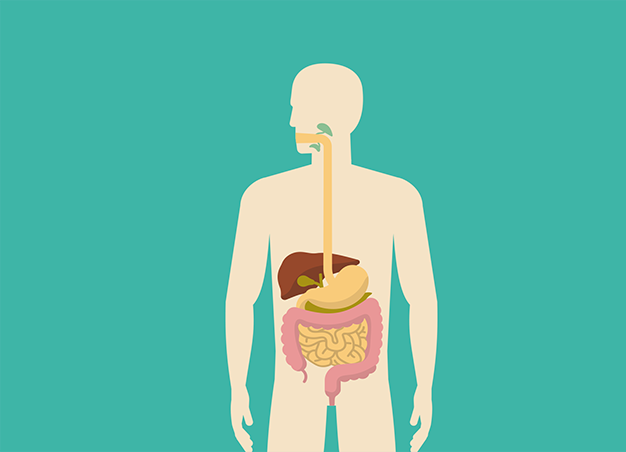More than 60% have gut issues. A survey finds that nearly two-thirds of adults are burdened by digestive trouble. According to the National Institutes of health, 60 to 70 million Americans suffer from one or more chronic digestive ailments, including acid reflux, bloating, abdominal pain, diarrhea, even hemorrhoids.
What is the gut? The gut is the blanket term used for the entire digestive system, also called the digestive tract or the gastrointestinal tract (GI tract). The gut is a series of hollow organs that ranges from where food goes in, to where it comes out.
Breaking down the digestive system: Your brain, mouth, throat, stomach, intestines, and other organs are made up of many complex systems that work together to break down food into nutrients that can be absorbed and used to fuel the body.
Approximately 60 to 70 million Americans suffer from one or more chronic digestive ailments, according to the National Institutes of Health. In a recent large-population survey of more than 71,000 adults, nearly two-thirds reported issues with the gut occurring in the previous week. This National GI survey also found that digestive diseases account for over 100 million doctor visits each year. Gastrointestinal (GI) conditions include acid reflux, diarrhea, constipation, gas, bloating, abdominal pain, even hemorrhoids (yep, that’s the endpoint of your gut. Your gut is the widespread nickname used to cover the entire digestive system that runs from your mouth to your anus. Your gastrointestinal tract used to be thought of as a constant on-duty chef, always prepared to take the food you’d chewed and swallowed and efficiently “cook it,” throw out the unusable bits of waste, and then to serve the best of the nutrients available to your body. It’s a bit more complicated than that. Here you’ll find information about the components that makes up the digestive system and how it functions. In a later article, you’ll learn nutritional, sleep, and exercise strategies you can practice to ramp up your gut health.
The Gut At-A-Glance:
There are many parts to the digestive system, and each has their own timing system and are responsible for specific functions that influence and interact with other areas of your gut, brain, and body. Read on for a breakdown of the many fascinating parts that work together to turn food into nutrients your body can use.
- Pre – Mouth: Yep. Before food even touches your tongue, seeing food, smelling its aroma, even hearing someone munching on food sets off the digestive system, and marks the activation of the cephalic phase of digestion. These cues trigger areas of your brain, which then send a signal to your gut to prepare gastric juices for the food to come. Even time-of-day can begin this phase. For example, if you regularly eat lunch at noon each day, your brain will start the cephalic phase (explained below) as that time approaches.
- Your Mouth: Your mouth is where your digestive tract physically begins and continues the cephalic (or oral) phase of digestion. As you chew, your mouth breaks down food into more easily digestible chunks, while saliva mixes in and begins to break down food into a substance (called bolus) your body can use. Your tongue massages glands that release more saliva and push the bolus into the throat to start the process of swallowing. The taste buds on your tongue also trigger increases in saliva and stomach acid to start digestion. Saliva is made mostly of water, but it’s also packed with powerful substances. In addition to water, saliva includes electrolytes and mucus that hydrate and protect, antibacterial compounds to kill harmful bacteria, and enzymes that break down food so it can move to the next digestive phase. Your mouth naturally produces more saliva after you wake in the morning and less at night when you sleep (which is why you might wake with a dry mouth at night).
- The Pharynx and Esophagus: Once your mouth and saliva have done their digestive duties, the gastric phase can begin. The pharynx is part of your throat that originates just behind your mouth and just above the esophagus. (Your pharynx also plays a role in breathing and speaking, but here we are focusing on digestion.) Each time you swallow, the pharynx passes food from your mouth to your esophagus. Your esophagus is a muscular tube that carries chewed food and fluids from your mouth to your stomach. Esophageal glands secrete mucus for moisture and lubrication to ease the
- The Stomach: Food remains in your stomach for two to five hours, depending on what and how much you eat. A mixer that churns and mashes together all food, your stomach uses gastric chemicals that come from the lining of its walls. Stomach acid needs to be kept at specific levels—potent enough to kill harmful bacteria that can cause illnesses or infection, but not so strong that it kills off beneficial bacteria and nutrients. Stomach acid is lowest in the morning. When you eat food, stomach acid spikes, but not all foods are equally digestible. Water digests the fastest, with sugars and carbs next in line. Protein and fats take longer to absorb. Once your stomach has finished digesting food, it can move into the next phase of digestion.
- The Intestines: Your intestines include your small and large intestine, your colon, as well as essential contributions from your pancreas and liver. There are numerous enzymes, hormones, and chemicals produced to further break down food into particle nutrients that can be absorbed and used by your body. Your intestines move food with muscular contractions, further absorbing nutrients and water and ultimately eliminating waste.
You now have a better idea of the multiple pieces that make up your complex digestive system. Stay tuned for strategies for better gut health via dietary suggestions, exercise guidelines, and sleep habits in upcoming articles.
 share
share


